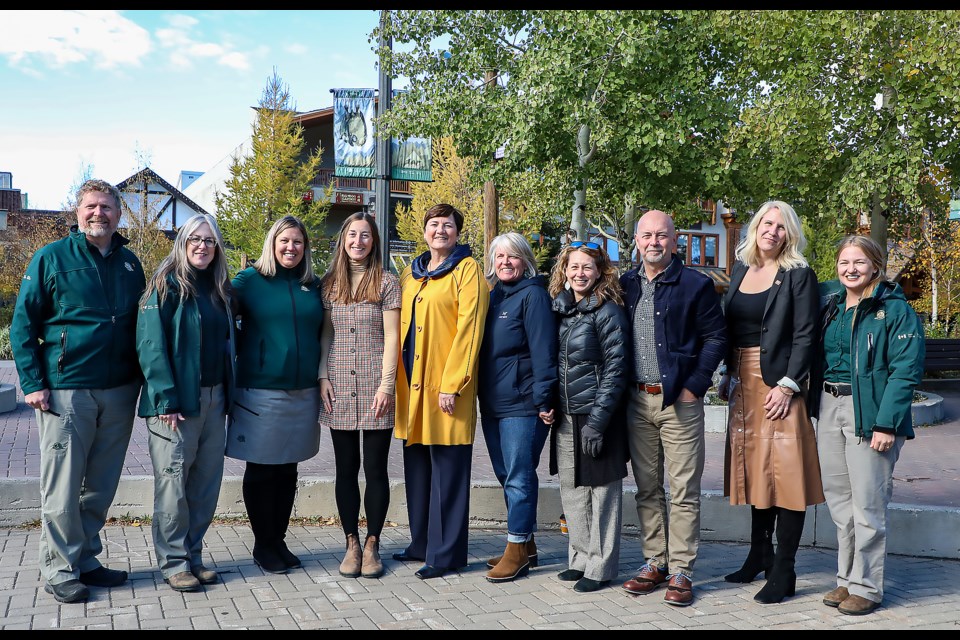BANFF – A Parks Canada plan to improve education for visitors to the Banff townsite about Banff National Park and Canada’s other national parks is finally coming together after almost 25 years.
The $8 million public feedback and planning phase for redevelopment of the east side of the 200 block of Banff Avenue will officially launch Oct. 12, with the goal of creating a space for visitor reception and expanding on people’s understanding of the challenges faced in protecting national park lands.
Senator Karen Sorensen, who is a former long-time Banff mayor, said this is an opportunity to improve the area for both visitors and residents.
“This is our chance to create a visitor reception area inclusive of all perspectives that will ensure meaningful results,” she said.
“This is a rare and important opportunity to make a meaningful lasting contribution to the visitors' understanding and appreciation for this iconic place and places like it.”
The public engagement process will begin Oct. 12 when letters are sent out to Indigenous communities as well as reaching out to stakeholders. It will also include running a local and national public campaign to get information from the public.
The first stage will allow for public feedback until June 23 and be followed by a summary of the feedback released in the summer of 2023, while the second stage will have conceptual designs for redevelopment presented between June and September 2024. A summary of the feedback on those designs will be released in the fall of 2024.
Andrew Campbell, the senior vice president of operations for Parks Canada, said it was a “once in a generation opportunity.”
He said Parks Canada will be contacting Indigenous groups with an interest in Banff National Park lands, but will also look for feedback from other Indigenous communities and organizations.
“It’s important for us on that path of relationship building towards reconciliation that those are the types of active offers and active consultation that can take place,” he said.
In 1998, Parks Canada announced plans to take back commercial leases on the east side of the 200 block of Banff Avenue, rezone the area and establish an environmental education centre.
The last piece of the puzzle was completed earlier this year when Bow Valley Credit Union at 216 Banff Ave. applied for a development permit for a new commercial-residential building at 206 Banff Ave.
The 2010 Banff National Park management plan declared Parks Canada’s intent to assemble lands on the east side of the 200 block of Banff Avenue.
The recently released 2022 management plan emphasized that Parks Canada would complete assembling the lands “for the development of facilities that enhance the connection of visitors in downtown Banff to the rest of the national park and that foster understanding of the ecology and human history of the area and support for conservation.”
The existing 200-block has parking, the Parks Canada visitor information centre, Banff Avenue Park – which was a former Esso gas station – and two additional buildings.
The federally legislated growth cap was put in place in 1998 to protect Banff National Park from potential environmental consequences as development took place. The total commercial floor area allowed in the Town of Banff is 361,390 square metres.
It was based on the development that already existed in the commercial districts at the time or that had been approved by Parks Canada before the growth cap was instituted and an additional 32,516 square metres of commercial space.
All commercial space was doled out in a random lottery by 2013, with most going to hotels and the remainder to retail and restaurants. The largest remaining unbuilt allocated space is the train station lands, which are part of Liricon Capital’s area redevelopment plan.
Among the priorities for the Parks Canada project on the 200 block of Banff Avenue will be sustainability, accessibility and building a connection with not only Banff National Park, but the entirety of Canada’s national park system.
“There will be a limit of what you would build in a national park and in the Town of Banff,” Campbell said. “Those will be the more limiting factors. … We’re trying to not tilt the engagement process one way or the other by putting a ceiling or a floor on it at this moment, but to have people bring back their ideas.”
The plan will examine the best use of public funding, Indigenous and public feedback, previous government commitments and the visitor experience among several considerations.
Sorensen, who joined Banff town council in 2004 and was mayor for 11 years before joining the Canadian Senate in 2021, will serve as a special advisor to the Banff National Park superintendent for planning and engagement on the plans for the east side of the 200 block.
She emphasized there are no preconceived notions about what the site could eventually be developed into, noting it is important to hear from the public.
“There have been many conversations over the years of what may go in this space and it’s a variety of conversations of welcoming visitors, but also celebrating Canada’s national park system. … All of us are anxious to see what the engagement will look like,” Sorensen said.
Those interested in submitting feedback can do so at: www.letstalkmountainparks.ca/200-block-banff-avenue-redevelopment.




